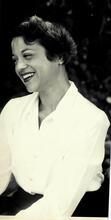Viola Brothers Shore
Born in New York, Viola Brothers Shore started an electrical contracting business with her husband before attending New York University, where she began her career as a writer. She wrote poetry, biographies, stories, and articles published in College Humor, Collier’s, and Saturday Evening Post, as well as plays, and sketches for New Faces, produced on Broadway in 1934. Her short stories, many about Jewish American lives of the day, were collected in The Heritage and Other Stories (1921). Shore also wrote silent movie titles and original stories for many films and collaborated on movies with other writers. She wrote numerous mystery stories and won several Ellery Queen awards. In 1954, Shore moved back to New York City, where she taught writing at New York University and continued writing.
Overview and Early Life
In 1920, in the Saturday Evening Post, Viola Brothers Shore wrote, “Someday I hope to live the kind of life where I’ll have nothing to think about but writing. Where I won’t have to scribble my poems in the subway on the back of the delicatessen bill, where if I file the darn thing under bills I’m out a poem and if I file it under poetry the delicatessen man has me in a tight place.” This statement characterizes the early struggles of Viola Brothers Shore, a writer of extraordinary versatility.
Born in New York City on May 26, 1890, she was the first child of Dr. Abram Brothers, a well-known surgeon who was also a writer, an actor, and a violinist who taught his daughter to play the violin. According to family lore, her mother, Minnie Epstein Brothers, descended from the first Term used for ritually untainted food according to the laws of Kashrut (Jewish dietary laws).kosher butcher in New York, was born following a dramatic escape from the New Orleans region where her father had shot a southern gentleman who was attacking his pregnant wife. He fled and later Minnie’s mother followed in a canoe paddled by a Native American guide. Viola had a sister, Madeleine, and a brother, Arthur J. Brothers, a lawyer.
Educated in public schools and at Normal College (now Hunter College), Viola left school at sixteen with musical aspirations. After these were cut short by her father’s illness, she enrolled in business school, then worked in an office and started an electrical contracting business with William Shore, an engineer whom she had married in 1912. Daughter Wilma Shore, who also became a successful writer, was born on October 12, 1913.
Writing Career
While attending New York University, Viola Brothers Shore began her career as a writer in a range of disciplines. She wrote poetry, biography (Stage Struck John Golden, 1930), stories and articles published in College Humor, Collier’s, and Saturday Evening Post; plays, including We Must Recruit! (1930) with Jeanne Manookian, Stage Struck (1930) with John Golden, Fools Rush In, and sketches for New Faces, produced on Broadway in 1934. Her short stories, many about Jewish American lives of the day, were collected in The Heritage and Other Stories (1921).
Shore wrote silent movie titles and original stories for many motion pictures including The Kibitzer (1929) and Walking on Air (1936). She also collaborated on movies with other writers, including Charles Kaufman, with whom she wrote Breakfast for Two (1937). She wrote numerous mystery stories, including The Beauty Mask Murder (1930) and Murder on the Glass Floor (1932) and won several Ellery Queen awards.
Divorced from William Shore in 1926, she later married Henry Braxton, a print dealer. In 1931, they moved to Hollywood and were divorced in 1933. In 1939, Shore married Haskoll Gleichman, a union activist; they divorced in 1945. She, Haskoll Gleichman, and her daughter Wilma were named during testimonies in the House Committee on Un-American Activities hearings.
In 1954, Shore moved back to New York City where she taught writing at New York University. Her papers indicate that in her latter years she was working on books about women in the writing business and about teaching. Viola Brothers Shore died in New York City on March 27, 1970.
SELECTED WORKS BY VIOLA BROTHERS SHORE
The Beauty Mask Murder (1930).
Breakfast for Two, with Charles Kaufman (1937).
The Heritage and Other Stories (1921).
The Kibitzer (1929).
Murder on the Glass Floor (1932).
New Faces: An Intimate Review, with Warburton Guilbert (1934).
No Limit, with Frank Tuttle (1930).
Stage Struck, with John Golden (1930).
Walking on Air (1936).
We Must Recruit!, with Jeanne Manookian (1930).
AJYB 24:203.
Ask, M.N., and S. Gershanek. Who Was Who in Journalism 1925–1928 (1978).
Bzowski, Francis Diodato. American Women Playwrights, 1900–1930 (1992).
Contemporary Authors. Vol. 16 (1975).
Coven, Brenda. American Women Dramatists of the Twentieth Century (1982).
Kalmar, Bert. The Life of The Party (1937).
Obituary. NYTimes, March 31, 1970, 41:3.
O’Brien, Edward J., ed. The Best Short Stories of 1919 (1919), and The Best Short Stories of 1920 (1920), and The Best Short Stories of 1921 (1921).
Queen, Ellery. One-Hundred-and-One Years’ Entertainment: The Great Detective Stories, 1841–1941 (1945), and The Queen’s Awards, 1947 (1947).
Shore, Viola Brothers. Papers, 1912–1970. Archives, The American Heritage Center, University of Wyoming, Laramie.
Vaughn, Robert. Only Victims (1972).
“Who’s Who and Why.” Saturday Evening Post (September 18, 1920).
WWIAJ (1926, 1928, 1938).



